Key takeaways:
- Displacement during conflict profoundly affects individuals emotionally and socially, leading to loss of identity and community.
- The Ukrainian conflict has resulted in over 1.5 million internally displaced people, straining local resources and services.
- Coping mechanisms among displaced families include storytelling, community networking, and creative outlets to maintain cultural identity and emotional well-being.
- Future policies must focus on integrating displaced individuals into communities and preserving their cultural identities to foster resilience and cohesion.
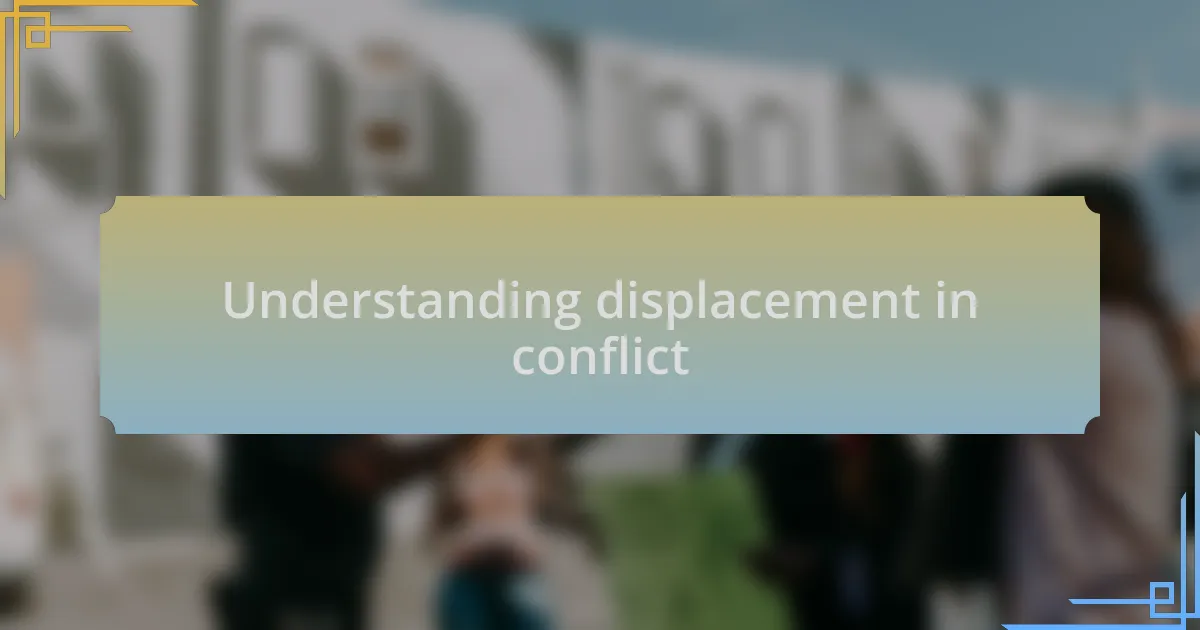
Understanding displacement in conflict
Displacement during conflict is a deeply human experience, often marked by loss and uncertainty. I recall a refugee from eastern Ukraine sharing how he left everything behind in a rush, clutching only a small bag with essentials. This brief encounter highlighted the stark reality that many individuals are forced to make harrowing choices under pressure, leaving their homes and communities forever altered.
When I consider the plight of the displaced, I can’t help but feel a profound sense of empathy. I often wonder, what is it like to uproot one’s life and journey into the unknown? For countless individuals, displacement isn’t just about geographical change; it’s about the emotional toll of leaving behind a lifetime of memories, familiar sights, and connections that were once a source of comfort.
Moreover, the consequences of displacement extend beyond the immediate loss. It can fracture social networks and erode cultural identity, leading to feelings of isolation and helplessness. I’ve seen how individuals struggle to rebuild their lives in unfamiliar settings, often longing for a sense of belonging amid chaos. This complexity of displacement makes it essential for us to advocate for understanding and support for those affected.

Overview of Ukrainian conflict
The Ukrainian conflict, which began in 2014, escalated tensions between Ukraine and Russia, primarily over issues of sovereignty and territorial integrity. I vividly remember watching news reports as the situation unfolded, realizing that the turmoil was not just a political dispute but a profound struggle that affected millions of lives. How does one measure the impact of a war that forces communities apart and disrupts daily life for countless families?
As hostilities intensified, regions like Donetsk and Luhansk became battlegrounds, leading to the internal displacement of over 1.5 million people within Ukraine. I often think about what it must feel like to see your hometown transformed into a war zone, where the familiar streets become unrecognizable. It’s heart-wrenching to consider how a place once filled with laughter and community spirit can suddenly turn into a site of fear and chaos.
The wider implications of this conflict ripple throughout the region and the world. Witnessing the outpouring of support from neighboring countries and international organizations gives me hope, yet I also feel a deep sadness for those who continue to suffer. The struggle for peace in Ukraine highlights the resilience of the human spirit, but it begs the question: how can we, as a global community, better support those caught in the crossfire?
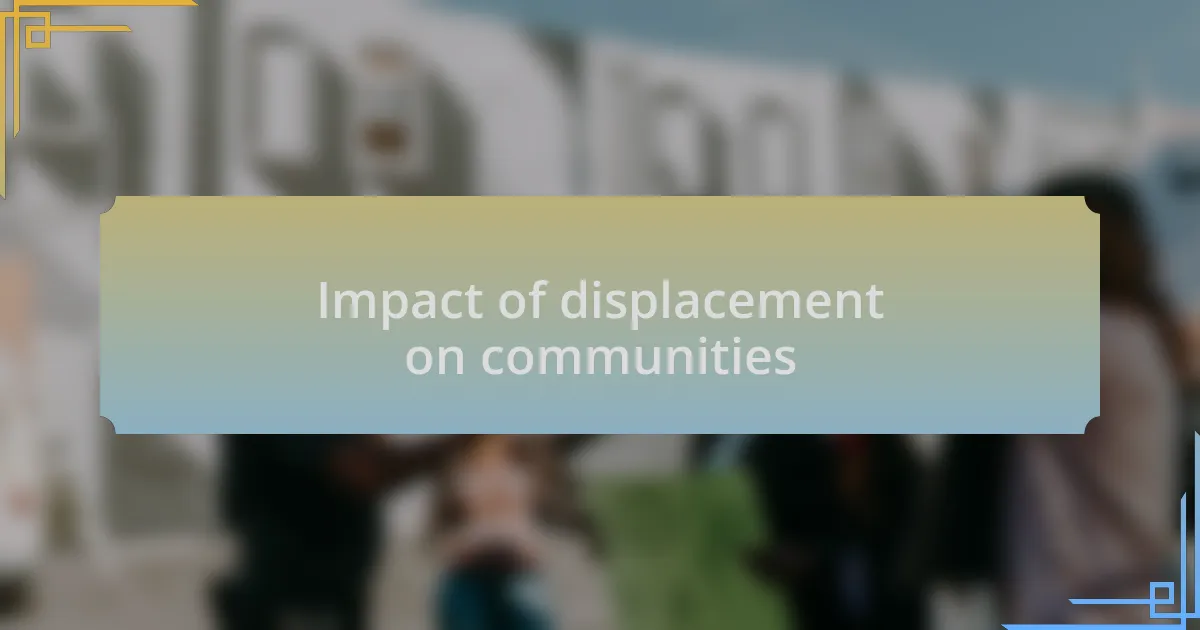
Impact of displacement on communities
The consequences of displacement during conflict reach far beyond mere numbers. I remember speaking with a displaced family from Donetsk who shared their battle to adapt in unfamiliar cities. It struck me how they not only lost their homes but also their sense of belonging, a core aspect that helps define who we are in our communities.
When families are uprooted, schools, healthcare, and local economies suffer tremendously. I recently read about a small town that welcomed refugees; it was inspiring yet heartbreaking. While the town’s spirit shone brightly with a desire to help, the sudden influx strained local resources and led to tensions amongst residents, raising the question: how do communities balance compassion with their own needs?
Moreover, the emotional toll on both displaced individuals and host communities often goes unrecognized. I met a local volunteer who expressed the joy of helping but also shared the frustration of feeling overwhelmed by the growing needs. Isn’t it intriguing how compassion can fuel unity but also highlight the fragility of communal bonds in times of crisis?
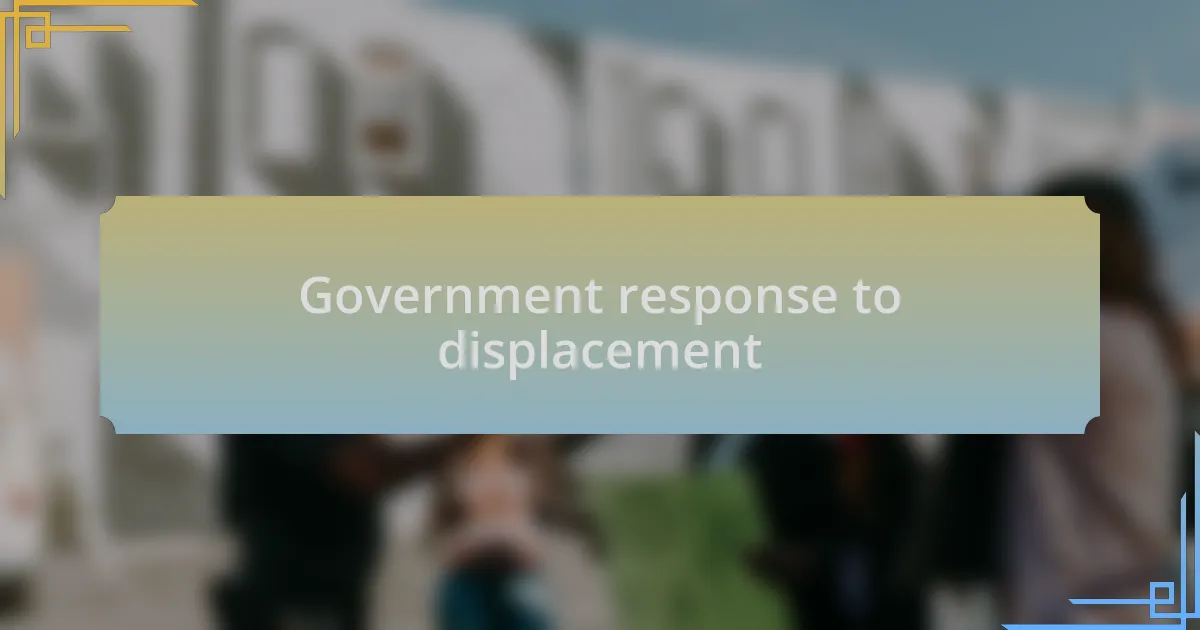
Government response to displacement
The Ukrainian government has taken significant steps to address the needs of displaced individuals, yet the complexities of this situation often leave gaps. I recall a conversation with a government worker who described their efforts to set up emergency shelters for those fleeing conflict. It was enlightening to hear how they were not only focused on providing a roof but also trying to create spaces where people could feel safe and cared for.
Yet, despite these efforts, there are challenges that remain. I met a woman who had recently been relocated to Lviv and she shared her struggle to navigate the bureaucratic process to access financial assistance. It made me think—how can a government streamline support when so many are in urgent need? This situation underscores the necessity for ongoing dialogue between the displaced and the authorities to ensure that support mechanisms are both practical and responsive.
Additionally, collaboration with NGOs and community organizations has become crucial in this effort. I remember attending a local meeting where different groups shared their resources to better assist displaced families. Isn’t it fascinating how solidarity among various organizations can enhance the government’s response? It feels like the true strength lies in a collective approach, revealing how interconnected our roles are in building resilience during these trying times.
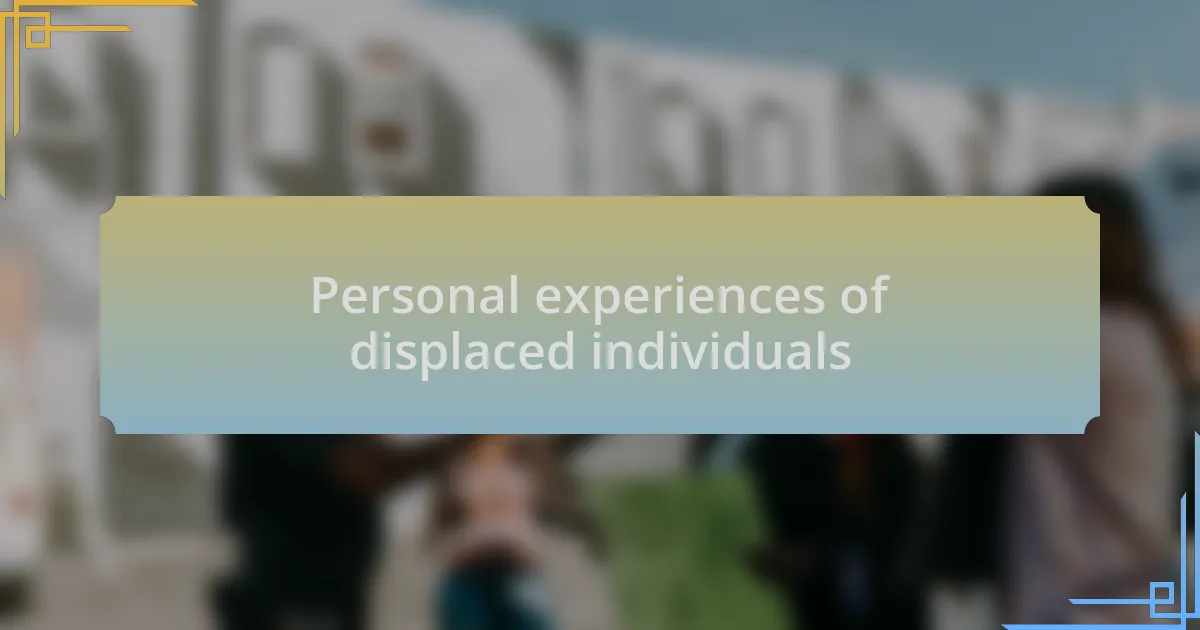
Personal experiences of displaced individuals
The experiences of displaced individuals are often filled with a mix of fear and hope. I remember speaking to a young man who fled from eastern Ukraine, and he conveyed a profound sense of loss for his home and community. He told me how, despite the trauma, he found solace in the unexpected kindness of strangers who welcomed him into their homes. It made me wonder—how can such simple acts of humanity provide comfort amidst chaos?
Another encounter that stuck with me was with an elderly woman in a local shelter. Her eyes were full of weariness, yet she shared stories of resilience, reminiscing about her garden left behind in her hometown. She spoke of the flowers she tended, her voice cracking with emotion. How do we quantify the attachment to our roots, especially when those roots are harshly severed? Her longing was palpable, and it opened my eyes to the profound psychological impact of displacement, far beyond just physical relocation.
There’s also the story of a family I met while volunteering at a community center. They had just arrived in Kyiv and were staying in temporary housing. The parents were worried not only about their children’s education but also the stigma they felt being labeled as “displaced.” I found myself thinking—what can be done to bridge that gap and foster a sense of belonging? Their determination to create a new life for their children, despite the uncertainty, was both inspiring and heartbreaking.

Coping mechanisms for affected families
Coping with displacement during conflict is a complicated journey for affected families, and my conversations with them often reveal varied strategies. One family I met utilized storytelling as a way to bond and maintain their cultural identity. They would gather in the evenings, sharing memories of their hometown, which seemed to weave a tapestry of strength and resilience to face the uncertainty that lay ahead. How powerful it is that such a simple act helps them reclaim a piece of their past in a new, unfamiliar environment!
Another coping mechanism I encountered is the building of community networks. I spoke with a mother who organized playdates for her children with other displaced families. She emphasized the importance of keeping their kids connected, saying, “They need to understand they’re not alone in this.” Her perspective really struck me; community support doesn’t just provide emotional shelter but can significantly enhance everyone’s wellbeing.
I also learned about the therapeutic role of creativity. A young girl I met expressed herself through art, filling blank canvases with colors reflecting her emotions. Her mother shared how this artistic outlet not only provided an escape but also facilitated conversations about their experiences. Isn’t it fascinating how creativity can bridge the gap between pain and healing? This insight reminds me that coping mechanisms are often as varied as the individuals experiencing displacement.
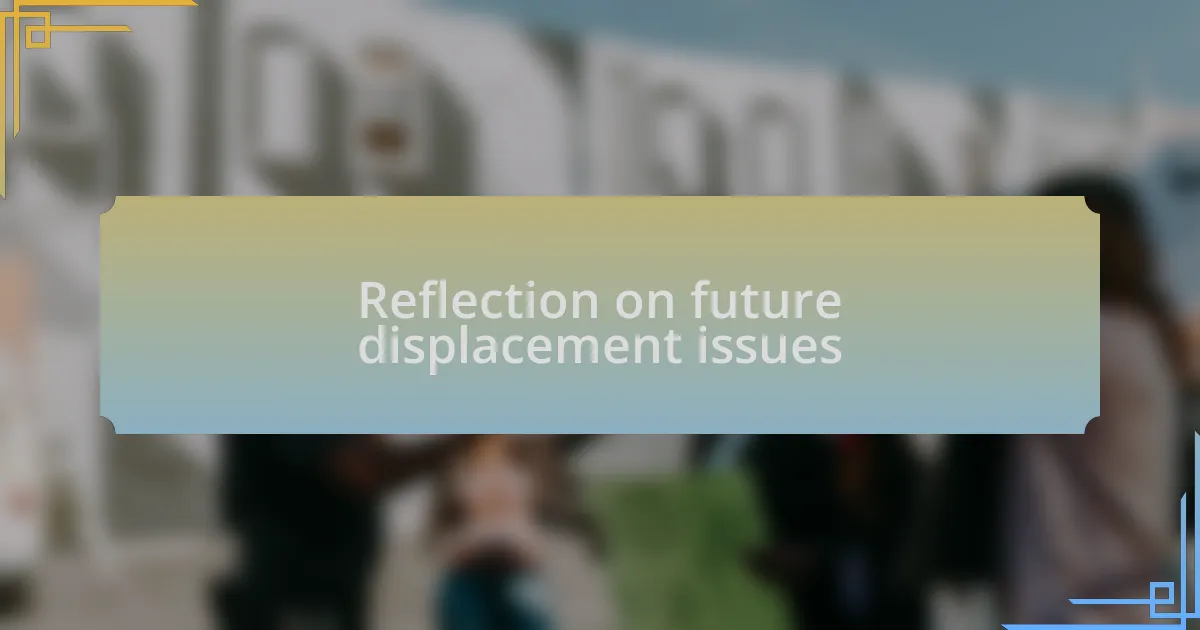
Reflection on future displacement issues
Reflection on future displacement issues
Looking ahead, I find myself deeply concerned about the ongoing realities of displacement in conflict zones like Ukraine. I once spoke with a young man who had fled his home, and he poignantly remarked that the concept of “home” feels increasingly abstract for him. How do we begin to tackle this emotional disconnect? It’s essential to think about the long-term psychological impacts of repeated displacements that may linger far beyond the immediate crisis.
Furthermore, as policies evolve, I believe it’s crucial that we prioritize the integration of displaced individuals into their new communities. During my time discussing these issues, I encountered a group of volunteers working tirelessly to connect newcomers with local resources. Their efforts reminded me of the ripple effect we can create when we foster understanding and collaboration. Have we considered how bridging the cultural gaps can lead to more cohesive societies?
Finally, future displacement policies should also focus on preserving cultural identities. I remember a poignant conversation with an elderly woman who reminisced about her traditional recipes. She shared her fear that the war could wipe away her culinary heritage. This spoke volumes to me; we must ask ourselves how we can ensure that the rich tapestries of diverse cultures within displaced populations remain vibrant even in the face of adversity. Addressing these reflections now could make a profound difference for generations to come.